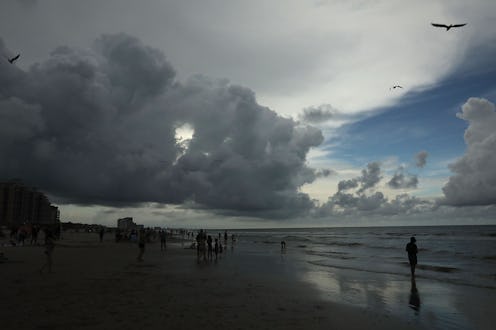News
Hurricane Irma Could Hit Myrtle Beach

After barreling through the Caribbean earlier in the week, Hurricane Irma is making its way toward Florida. The Category 4 storm is expected to hit southern Florida on Saturday, and over 5 million of the state's residents have been ordered to evacuate their homes before it does. But the storm's impact won't be confined to the Sunshine State: It's possible that Hurricane Irma could hit Myrtle Beach, South Carolina, as well as other coastal communities to Florida's north — although the storm's effects in those regions are expected to be relatively mild.
Irma's path is being constantly updated, and given that it hasn't even made landfall in Florida yet, it's impossible to say with certainty whether or where it will hit in South Carolina. The National Weather Service currently projects that the storm will sweep up Florida, then veer west through Georgia before reaching in Tennessee on Wednesday. Because the storm is around 400 miles wide (at time of writing), there's a possibility that it will affect other states in the region, including Alabama, Mississippi, and South Carolina.
As a result, the city of North Myrtle Beach has declared a state of emergency, reported local newspaper The Sun News on Friday. President Trump has done the same for the state as a whole, which will allow South Carolina to receive federal funds as it prepares for the hurricane.
North Myrtle Beach Public Information Office Pat Dowling told The Sun News:
We always tie into that strictly because we want to ensure that if we receive anything from the storm and there's any kind of damage then we can access resources from FEMA. You have to have passed those documents in order to participate.
According to the National Weather Service, it's possible that the greater Myrtle Beach region will see 3 to 5 inches of rain as Irma makes its way toward the state.
According to The Sun News, Steve Pfaff, a meteorologist with the National Weather Service, told a press briefing:
Rainfall amounts of 1-5 [inches] are possible, with the higher amounts expected generally south of a Florence to Myrtle Beach line. Some areas could receive flooding as a result especially since some areas across northeast South Carolina are 125 to 150 percent above normal rainfall over the last 14 days.
In general, Irma is expected only to bring "fringe effects" to the Myrtle Beach area, according to WMBF, including minor coastal flooding. But although South Carolina Gov. Henry McMaster has issued mandatory evacuation orders for several islands off the state's coast, no such orders are in place in Myrtle Beach.
"Although the latest Hurricane Irma forecasts are increasingly favorable for South Carolina, the National Weather Service still expects Irma to cause high winds, heavy rains and localized flooding due to a possible storm surge of four to six feet," McMaster said in a press release. Storm surge is what occurs when a hurricane "drags" ocean water towards shores as it approaches a coast, resulting in flooding.
Irma is still expected to hit Florida the hardest, however. Although it was downgraded to a Category 4 storm shortly after tearing through the Caribbean, the National Weather Service has since projected that it will strengthen back to Category 5 as it hits the Florida Keys on Sunday. As of this writing, it's carrying sustained maximum winds of 155 miles per hour, and mandatory evacuation orders are in effect in Brevard, Broward, Collier, Indian River, Martin, Miami-Dade, Monroe, Palm Beach and St. John counties. In total, over 6.3 million Floridians — more than a quarter of the state's entire populace — have been told to evacuate.
"Hurricane Irma continues to be a threat that is going to devastate the United States in either Florida or some of the southeastern states," said FEMA administrator Brock Long at a press conference Friday morning. "We're going to have a couple rough days."
If you live anywhere near Irma's projected path, it's best to err on the side of caution, and take all local advisories seriously.